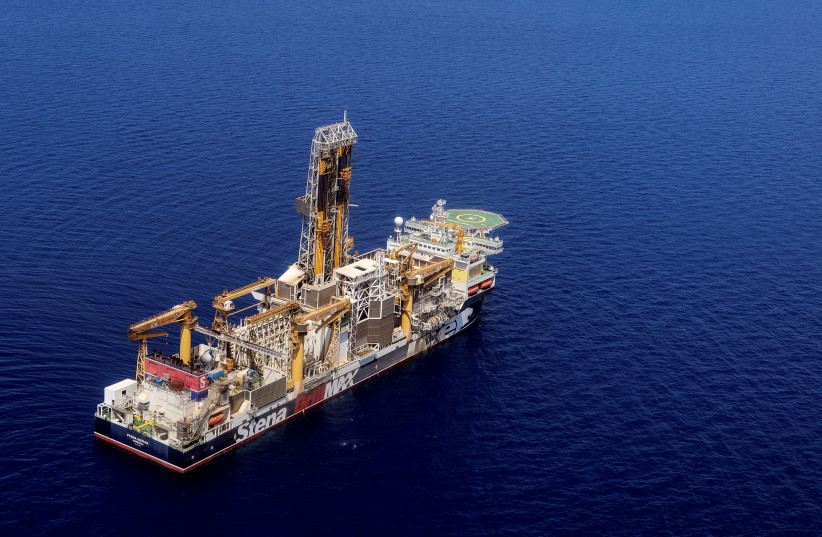In the middle of a sunny Saturday, Hezbollah launched three drones from Lebanon’s coast towards Israel’s Karish gas rig. Before they got to their target, they were shot out of the sky by an F-16 and two missiles fired from a Barak 1 missile defense system on the INS Eilat.
With its first operational success, the Barak 1 has shown that it can intercept one of the most challenging threats to Israel Air Force platforms: low-flying and slow unmanned aerial vehicles (UAV).
Though the drones were unarmed, it was a clear message by the Lebanese terror group that continues to flex its propaganda muscles against the IDF and Israel.
Hezbollah regularly releases images of IDF troops along the northern land border as well as of small Lebanese fishing vessels against the backdrop of Israeli Navy ships.
The Iranian-backed terror group has also flown drones into the Jewish state. One most recently traveled all the way to Tiberias before the IDF tried to intercept it with an Iron Dome Tamir missile.

A critical time
But the launching of three drones towards the Karish gas rig comes at a critical time, a week before the visit of US President Joe Biden and as Israel got its new prime minister, Yair Lapid, the country’s 14th.
Lebanon and Israel have been carrying out negotiations with US brokerage over their exclusive economic zones (EEZ) and Hezbollah has warned against Israel using the Karish gas rig, a platform that Jerusalem sees as a strategic asset within its territorial waters.
Israel is highly dependent on the sea with over 90% of its imports arriving via maritime channels. While the country’s navy is relatively small compared to other IDF corps, it has a significant amount of territory to protect since the expansion of the country’s EEZ from 40 miles (64 km.) from shore to 150 miles (241 km.).
Israel’s exclusive economic zone and strategic facilities face diversified threats in the marine arena, including drones, anti-ship missiles and other platforms used by Hezbollah in Lebanon and Hamas in the Gaza Strip.
Israeli gas rigs have been targeted in the past, including by Hamas during the country’s Operation Guardian of the Walls last May.
Hezbollah is reported to have some 2,000 drones and, with the price of UAVs being relatively cheap compared to the interceptor missiles, Israel’s defense establishment believes that it will attempt similar operations in the future.
The terror group likely has advanced UAV models such as the Mohajer, Shahed, Samed (KAS-04), Karrar and Saegheh types. It also possesses dozens of smaller civilian drones made by China that are used for photography as well as to carry and drop bombs.
Israel's message
The use of the Barak 1, a short-range, surface-to-air missile naval air-defense system, is also a message from Israel to Hezbollah: Don’t test us – we will shoot you down.
FORMER COMMANDER of the Israel Navy V.-Adm. (ret.) Eliezer Marum told The Jerusalem Post that the interception of the drones was an “extraordinary success.”
While Israel has had to deal with terror attacks, rockets and other threats, “the threats posed by UAVs are new,” he said.
When he was in command, drones and other unmanned aircrafts weren’t “a threat at all – it was just starting out,” he said. “We knew that it was going to be a serious threat, and over the years it has” become one.
The IDF understood even then that the threat to “Israel’s economic waters, more than direct terror attacks by vessels or divers, will be rockets fired from Lebanon or drones,” Marum said.
Though the former navy commander retired from active service in 2012, he explained that the IAF began work to upgrade the navy’s capabilities including new missile ships, new radar systems and the Barak 8.
The Barak 1 has been operational for 16 years and is used by the Israel Navy, the Indian Navy, Chile and Singapore. The system is designed to defend naval vessels against a myriad of short-range (reported to be up to 12 km.) airborne threats like incoming missiles, planes and drones at both low or high altitudes with a warhead weighing 22 kg. and a maximum altitude of 5.5 km.
The navy’s new Sa’ar 6 corvettes, which docked in Haifa Port over the last year, are fitted with the upgraded Barak 8, which is capable of carrying a warhead of up to 60 kg. and can hit targets some 70-150 km. away at altitudes of up to 30 km.
The Barak 8 integrates several advanced state-of-the-art systems including digital radar, command and control, launchers, interceptors with modern RF (radio frequency) seekers, data links and system-wide connectivity. It is also capable of engaging with multiple targets simultaneously in severe saturation scenarios and can be operated in all types of weather.
The success of the Barak 1 system and the addition of the Barak 8 is critical for Israel, since the next time Hezbollah launches threats against targets, they just might be explosive.
